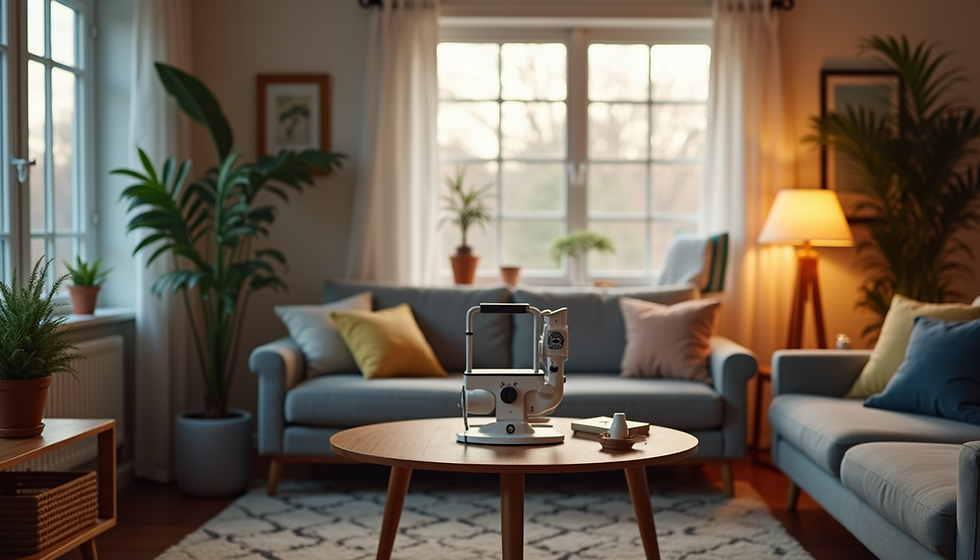The Impact of Poor Vision on Fall Risk in Older Adults
- daveellisdo
- Jun 27
- 4 min read

Falls are a major concern for older adults, often leading to severe injuries and/or loss of independence. One critical yet frequently overlooked factor is poor vision. As people age, their eyesight tends to decline, making them more vulnerable to tripping, stumbling, and losing balance. This blog post will explore how poor vision affects fall risk in older adults and what can be done to reduce these risks.
Understanding the Connection Between Poor Vision and Falls
Research shows a clear connection between poor vision and the likelihood of falls among older adults. Vision is crucial for spatial awareness, depth perception, and the ability to navigate surroundings. For example, studies indicate that older people with visual impairments are twice as likely to fall compared to those with normal eyesight.
Many older adults experience vision issues such as cataracts, glaucoma, and macular degeneration. These conditions can lead to significant changes in eyesight, making it difficult to identify hazards like uneven surfaces, steps, and even other people in their path. In fact, a report found that nearly 40% of older adults with vision problems reported falling at least once in the past year.
Vision and Balance
Balance plays an essential role in preventing falls. Vision provides vital feedback about the surrounding environment, which helps people maintain stability. When eyesight declines, the nervous system tends to depend more on signals from the inner ear and the body's sense of position, both of which may not provide accurate information. This over-reliance can lead to unsteadiness.
Additionally, many older adults face health issues such as arthritis or neuropathy that can further hinder their ability to stay balanced. A study found that older adults with both vision impairments and conditions affecting balance experienced a 50% higher risk of falling than those without these combined challenges.
Environmental Hazards
Poor vision can make it difficult for individuals to spot environmental hazards. Dim lighting, cluttered living areas, and low color contrast can create dangerous situations. For example, a poorly lit hallway or stairs without handrails can pose serious dangers to those with compromised eyesight.
By adapting living spaces to be more visibility-friendly, the risk of falls can decrease significantly. Simple changes, such as enhancing lighting, decluttering spaces, and using contrasting colors around stairs and door frames, can greatly improve safety. A study noted that older adults who made environmental modifications reduced their fall rate by nearly 30%.
The Role of Regular Eye Examinations
Regular eye examinations are vital for maintaining eye health and preventing vision-related falls. Eye exams can help catch problems early, allowing for prompt intervention. For older adults, it’s recommended to get eye checks at least once a year.
During these exams, healthcare providers can identify issues like cataracts or macular degeneration early on, allowing for treatment options ranging from corrective lenses to a referral for surgical procedures. Keeping prescriptions current ensures that individuals maintain the clearest vision possible while navigating their environments.
Vision Rehabilitation Services
For older adults facing significant vision loss, rehabilitation may be necessary. Vision rehabilitation services provide essential support through specialized training tailored to individual needs. These programs focus on maximizing remaining vision or teaching safer, alternative strategies to perform daily tasks.
Through vision rehabilitation, older adults can learn how to adapt their homes, utilise visual aids, and develop skills to enhance their safety and confidence. Those who engage with these services can significantly lower their fall risk and feel more independent.
Assistive Technology
In today’s digital age, assistive technology has emerged as an innovative solution for older adults experiencing vision loss. Devices such as smart glasses, magnifiers, and smartphone applications designed to enhance visibility can empower individuals.
For instance, certain smartphone apps can read text aloud, describe surroundings, or provide navigation assistance. Incorporating such tools into daily life not only enhances safety but also promotes independence, enabling older adults to actively participate in their communities.
Community Resources and Support
Community resources are essential for helping older adults manage their vision and overall health. Local organizations may offer free vision screenings, educational workshops, and support groups where individuals can share experiences and strategies.
Many communities also provide transportation services that accommodate those with vision impairments. This ensures that they can access healthcare appointments, social events, and grocery stores.
Older adults should reach out to these resources for support and guidance. Building a supportive community can be key to enhancing safety and improving mental well-being.
Final Thoughts
The impact of poor vision on fall risk in older adults is a critical public health issue. It’s important to acknowledge the relationship between vision impairments and the increased likelihood of falls. Proactive steps, such as regular eye exams, environmental modifications, vision rehabilitation services, and using assistive technology, can significantly lower this risk.
By increasing awareness and providing strong support, we can help older adults maintain their independence and quality of life. Ensuring their safety allows them to live confidently in their homes and communities. Addressing the challenges posed by poor vision is a collective effort that can lead to significant improvements in health outcomes for older adults.







Comments